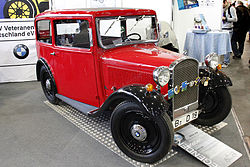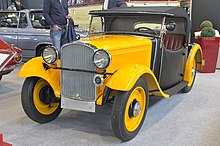BMW 3/20
| BMW | |
|---|---|
| 3/20 hp | |
| Production period: | 1932-1934 |
| Class : | Small car |
| Body versions : | Touring car , roadster , limousine , convertible sedan , convertible |
| Engines: |
Otto engine : 0.8 liters (15 kW) |
| Length: | 3200 mm |
| Width: | 1420 mm |
| Height: | 1550 mm |
| Wheelbase : | 2150 mm |
| Empty weight : | 650 kg |
| Previous model | BMW 3/15 PS |
| successor | BMW 309 |
The BMW 3/20 was the further development of the BMW 3/15 PS model from the German vehicle manufacturer BMW . It was manufactured in Eisenach between 1932 and 1934 .
history
In 1932, BMW let the license agreement with Austin for the BMW 3/15 PS expire on March 1, 1932 a few weeks before the introduction of its own 3/20 AM 1 - the first in-house development of a small car had already started in Munich in 1931.
development
The small car built in Eisenach had become larger and more comfortable thanks to a new chassis with a 25 cm longer wheelbase and the engine, which was a third more powerful. The body was on the mediation of the Daimler-Benz - chairman Wilhelm Kissel , who sat from 19 March 1932 the Supervisory Board of BMW in Sindelfingen plant manufactures and purchased by BMW. This cooperation led to BMW automobiles being sold in the agencies of Daimler-Benz AG .
marketing
The price of the sedan at the beginning of the construction period was RM 2,825; in February 1933 it was only 2650 RM. In the price list from January 1934, only the sedan with and without a roll top was listed with unchanged prices.
After 7215 units, BMW stopped production in 1934. Despite the economic success, there was no successor of the same size; From 1936, after two years of building the BMW 309 - a BMW 303 with the four-cylinder engine of the BMW 3/20 - BMW continued to exclusively produce modern and powerful vehicles with six-cylinder engines .
technology
engine and gears
The BMW 3/20 was powered by a water-cooled four-cylinder engine with a displacement of 782 cm³ and 20 hp (15 kW). Compared to the Austin design in the BMW 3/15 , the new engine was equipped with an OHV cylinder head, the displacement increased by 4 millimeters from 749 cm³ to 782 cm³. The cooling water in the M68 engine circulated a water pump for the first time at BMW.
The unsynchronized three-speed transmission of types AM 1 and AM 3 replaced a four-speed transmission in the AM 4 .
Body and chassis
The two-door body, which was bought by Daimler-Benz AG , was made entirely of steel like its predecessor. The floor assembly screwed to the central low frame contributed to the stability of the chassis.
The rear axle was designed as an elaborate swing axle , but it was not convincing. Two transverse leaf spring packages guided and sprung the rear wheels. After this design, BMW returned to the rigid axle for the successor model and all other passenger cars . It wasn't until the BMW 600 from 1957 that the rigid axle was abandoned.
The front wheels were guided by a single transverse leaf spring package, and additional thrust struts provided support in the longitudinal direction.
The drum brakes on all four wheels were operated mechanically.
Executions
BMW only used the designations AM 1 , AM 3 and AM 4 in spare parts lists and documentation. In customer-related documents such as advertising brochures, advertisements and manuals, only the designations BMW car 3/20 PS or 0.8 liter / 20 PS appeared, regardless of the year of construction and the series .
Construction series
- AM 1: March 1932 to December 1932
- AM 3: November 1932 to May 1933
- AM 4: February 1933 - March 1934
Body styles
The types AM 1 , AM 3 and AM 4 were produced ex works :
- 5055 sedans
- 800 roll-top sedans
- 53 delivery vans
- 252 open four-seater
- 405 open two-seater
- 11 sports convertibles
- 471 two-door convertibles
- 168 chassis for special bodies
The special bodies were mostly created as open bodies; for example at Reutter in Stuttgart, Ludwig Weinberger in Munich and the bodyworks in Weinsberg in Weinsberg.
Web links
- Model BMW 3/20 PS AM 1. In: BMW History. BMW AG, accessed on January 10, 2016 (dossier in the BMW Group archive with technical data).
- Manual for the 0.8 liter / 20 hp BMW vehicle (AM1). In: BMW history. BMW AG, 1932, accessed on January 10, 2016 (manual with pictures, 51 pages).
- Spare parts list for the 0.8 liter / 20 hp BMW motor vehicle (AM1). In: BMW history. BMW AG, 1932, accessed on January 10, 2016 (complete spare parts list with pictures, 77 pages).
Individual evidence
- ↑ Wilhelm Dr. H. c. Kissel. In: BMW history. BMW AG, accessed on January 11, 2016 (curriculum vitae in the BMW Group Archive): “Kissel was involved in the creation of the 1926 interest agreement between BMW AG and Daimler-Benz AG. This rapprochement also led to Daimler-Benz manufacturing the bodies for the BMW 3/20 and enabling the sale of BMW automobiles in agencies of Daimler-Benz AG. "
- ↑ Henne am Harras shop window. In: BMW history. BMW AG, 1932, accessed on January 11, 2016 (photo in the BMW Group Archive): "BMW together with Mercedes in the shop window with the label \ 'Henne am Harras \'."
- ↑ a b c d The new BMW car 3/20 PS. In: BMW history. BMW AG, March 1932, accessed on January 10, 2016 (brochure with pictures in the BMW Group archive): "Original Mercedes-Benz body of perfect quality and beauty."
- ↑ Price list 4 cylinder 0.8 ltr / 20 HP small BMW car. In: BMW history. BMW AG, February 1933, accessed on January 11, 2016 (document in the BMW Group Archive).
- ↑ Price list 4 cylinder 0.8 ltr / 20 HP small BMW car. In: BMW history. BMW AG, January 1934, accessed on January 11, 2016 (document in the BMW Group Archive).
- ↑ BMW 3/20 PS four-cylinder engine M68. In: BMW history. BMW AG, 1932, accessed on January 11, 2016 (photo in the BMW Group Archive).
- ↑ a b Type BMW 3/20 PS AM 4. In: BMW History. BMW AG, accessed on January 11, 2016 (dossier in the BMW Group Archive).
- ↑ BMW 3/20 PS rear axle drive (drawing). In: BMW history. BMW AG, 1932, accessed on January 14, 2016 (document in the BMW Group Archive).
- ↑ BMW 3/20 PS, frame head with front axle (drawing). In: BMW history. BMW AG, 1932, accessed on January 14, 2016 (document in the BMW Group Archive).
- ↑ BMW 3/20 PS, cable brake (drawing). In: BMW history. BMW AG, 1932, accessed on January 14, 2016 (document in the BMW Group Archive).
- ↑ Another model of the new 0.8 liter / 20 hp BMW, the Sunshine Sedan. In: BMW history. BMW AG, 1932, accessed on January 14, 2016 (document in the BMW Group Archive).
- ↑ a b Type BMW 3/20 PS AM 1. In: BMW History. BMW AG, accessed on January 14, 2016 (dossier in the BMW Group Archive).
- ↑ Type BMW 3/20 PS AM 3. In: BMW History. BMW AG, accessed on January 14, 2016 (dossier in the BMW Group Archive).
| Timeline of the Dixi , BMW and EMW models from 1927 to 1955 | |||||||||||||||||||||||||||||||
|---|---|---|---|---|---|---|---|---|---|---|---|---|---|---|---|---|---|---|---|---|---|---|---|---|---|---|---|---|---|---|---|
| Type | 1920s | 1930s | 1940s | 1950s | |||||||||||||||||||||||||||
| 6th | 7th | 8th | 9 | 0 | 1 | 2 | 3 | 4th | 5 | 6th | 7th | 8th | 9 | 0 | 1 | 2 | 3 | 4th | 5 | 6th | 7th | 8th | 9 | 0 | 1 | 2 | 3 | 4th | 5 | 6th | |
| Small car | Dixi 3/15 | ||||||||||||||||||||||||||||||
| BMW 3/15 | 3/20 | ||||||||||||||||||||||||||||||
| Lower middle class | 309 | ||||||||||||||||||||||||||||||
| 303 | 315 | ||||||||||||||||||||||||||||||
| Middle class | 319/329 | 320 | 321 | ... | 321/2 | ||||||||||||||||||||||||||
| 326 | ... | 326/2 | 340 | EMW 340 | |||||||||||||||||||||||||||
| upper middle class | 335 | ||||||||||||||||||||||||||||||
| Roadster / Coupé / Convertible | BMW Wartburg | 315/1 / 319/1 | 327 | ... | 327 | EMW 327 | |||||||||||||||||||||||||
| 328 | |||||||||||||||||||||||||||||||
| Kübelwagen | 325 | EMW 325 | |||||||||||||||||||||||||||||
|
|
|||||||||||||||||||||||||||||||



